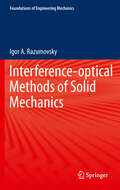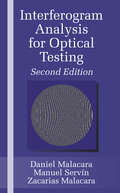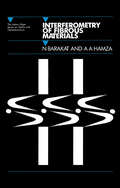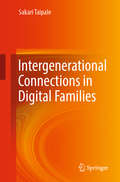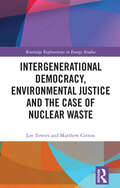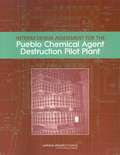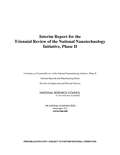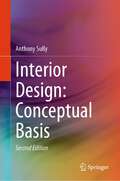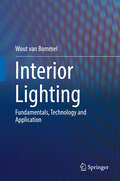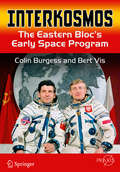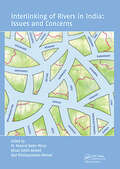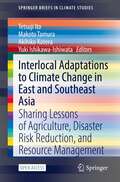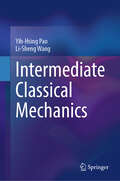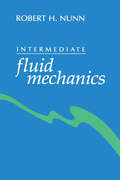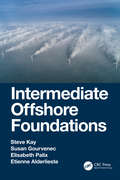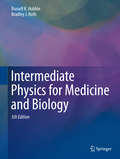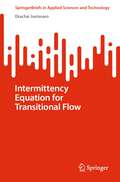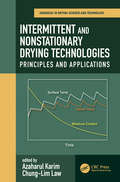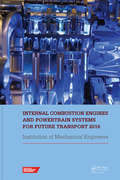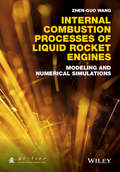- Table View
- List View
Interference-optical Methods of Solid Mechanics
by Igor A. Razumovsky Galkin Anatoliy YakovlevichThis reference tutorial contains modern experimental approaches to analysis of strain-stress distribution based on interference-optical methods of registration of strain or displacement fields, including coherent-optical techniques (holographic interferometry, speckle photography, electronic digital speckle interferometry techniques) and photoelastic methods as well as the shadow optical method of caustic. The book describes the theory, efficient scope of application in the every-day practice and the problems of further development of these techniques. Much attention is paid to new and promising advanced developments in the field of observation and computational methods for study of residual stress, determination of fracture mechanics parameters and material deformation characteristics. The content corresponds to the course of lectures delivered by the author at the N.E. Bauman Moscow State Technical University. It is intended for technical university students, research engineers and postgraduate students who are doing analysis of strain-stress state and strength of structural elements.
Interferogram Analysis For Optical Testing
by Zacarias Malacara Manuel ServínIn this day of digitalization, you can work within the technology of optics without having to fully understand the science behind it. However, for those who wish to master the science, rather than merely be its servant, it's essential to learn the nuances, such as those involved with studying fringe patterns produced by optical testing interferometers.When Interferogram Analysis for Optical Testing originally came to print, it filled the need for an authoritative reference on this aspect of fringe analysis. That it was also exceptionally current and highly accessible made its arrival even more relevant. Of course, any book on something as cutting edge as interferogram analysis, no matter how insightful, isn't going to stay relevant forever. The second edition of Interferogram Analysis for Optical Testing is designed to meet the needs of all those involved or wanting to become involved in this area of advanced optical engineering. For those new to the science, it provides the necessary fundamentals, including basic computational methods for studying fringe patterns. For those with deeper experience, it fills in the gaps and adds the information necessary to complete and update one's education. Written by the most experienced researchers in optical testing, this text discusses classical and innovative fringe analysis, principles of Fourier theory, digital image filtering, phase detection algorithms, and aspheric wavelength testing. It also explains how to assess wavefront deformation by calculating slope and local average curvature.
Interferometry of Fibrous Materials
by N Barakat A A HamzaInterferometry of Fibrous Materials shows how interferometric methods can be used in optical, synthetic, and natural fiber analysis. This practical volume features a large number of both color and black and white interferograms to enhance understanding of how interferometry is used to determine a fibre's optical properties.
Intergenerational Connections in Digital Families
by Sakari TaipaleThis book provides a comprehensive review of how digital communication technology can help families network and communicate across generations, despite differences in family composition, residential location, cultural values and orientations. Covering the full spectrum of intergenerational relations (including child to parent, and parent to grandparent), it offers a positive view of the value of digital technology usage within families.The author focuses on three European countries: Finland, Italy and Slovenia, but also touches on other European countries and parts of the United States, revealing evidence that challenges ideas of universal adoption of information communication technology (ICT) and consistency in the social effects of such adoption in different regions and cultures. Further, the book discusses numerous other challenges and issues, such as:• the social transformations and technological developments that have made digital families possible;• the resulting changes in family roles, responsibilities, and practices; and• the theoretical and conceptual implications of digital communication-technology use in families.The author illustrates how ICT can facilitate family solidarity and how it helps to provide new ways of being together, and they discuss how social media, particularly instant messaging applications, helps develop affinity between family members better than traditional one-to-one personal communication tools. Combining highly nuanced material with fresh sociological thinking, it enhances readers’ theoretical understanding of the meaning of the ‘digital family’, making it a powerful resource for graduate and undergraduate students, as well as academics. Thanks to its structured format with easy-to-understand explanations, it appeals to practitioners and researchers alike.
Intergenerational Democracy, Environmental Justice and the Case of Nuclear Waste (Routledge Explorations in Energy Studies)
by Matthew Cotton Lee TowersThis book explores the interplay between intergenerational justice and intragenerational justice using nuclear waste management as a consistent case to explore these themes.Lee Towers and Matthew Cotton examine the issue of intergenerational justice from a social scientific perspective, drawing on central case studies of nuclear waste management in Canada, Finland, and the United Kingdom. They connect indigenous philosophies and notions of justice with the concept of intergenerational democracy, advocating for better inclusion of youth and elders in decision-making that affects their well-being. As such, the book’s primary objectives are fourfold: To assess whether trade-offs between intergenerational and intragenerational justice are necessary, and if so, what these trade-offs are and how they might be resolved.To critically assess dominant western liberal philosophical approaches that shape contemporary intergenerational justice thinking in policy and practice, and consider alternatives drawn from anthropology and indigenous philosophies.To assess how far our current capitalist system can achieve substantive forms of justice.To critically examine three nuclear waste management case studies and assess how far these achieve environmental and energy justice and how they exemplify tensions between inter- and intragenerational justice. This short, accessible volume will be of great interest to students and scholars of energy, environmental justice, and ethics.
Interim Design Assessment for the Pueblo Chemical Agent Destruction Pilot Plant
by National Research CouncilIn 1996, Congress enacted directing the Department of Defense to assess and demonstrate technology alternatives to incineration for destruction of the chemical weapons stored at Pueblo Chemical and Blue Grass Army Depots. Since then, the National Research Council (NRC) has been carrying out evaluations of candidate technologies including reviews of engineering design studies and demonstration testing. Most recently, the NRC was asked by the Army to evaluate designs for pilot plants at Pueblo and Blue Grass. These pilot plants would use chemical neutralization for destroying the chemical agent and the energetics in the munitions stockpiles of these two depots. This report provides the interim assessment of the Pueblo Chemical Agent Destruction Pilot Plant (PCAPP) to permit adjustment of any significant problems as soon as possible. The report presents an analysis of the issues about the current PCAPP design and a series of findings and recommendations about ways to reduce concerns with involve the public more heavily in the process.
Interim Report for the Triennial Review of the National Nanotechnology Initiative, Phase II
by Committee on Triennial Review of the National Nanotechnology Initiative: Phase IINanotechnology has become one of the defining ideas in global R&D over the past decade. In 2001 the National Nanotechnology Initiative (NNI) was established as the U. S. government interagency program for coordinating nanotechnology research and development across deferral agencies and facilitating communication and collaborative activities in nanoscale science, engineering, and technology across the federal government. The 26 federal agencies that participate in the NNI collaborate to (1) advance world-class nanotechnology research and development; (2) foster the transfer of new technologies into products for commercial and public benefit; (3) develop and sustain educational resources, a skilled workforce and the supporting infrastructure and tools to advance nanotechnology; and (4) support the responsible development of nanotechnology. As part of the third triennial review of the National Nanotechnology Initiative, the Committee on Triennial Review of the National Nanotechnology Initiative: Phase II was asked to provide advice to the Nanoscale Science, Engineering, and Technology (NSET) Subcommittee and the National Nanotechnology Coordination Office in three areas: Task 1 - Examine the role of the NNI in maximizing opportunities to transfer selected technologies to the private sector, provide an assessment of how well the NNI is carrying out this role, and suggest new mechanisms to foster transfer of technologies and improvements to NNI operations in this area where warranted. Task 2 - Assess the suitability of current procedures and criteria for determining progress towards NNI goals, suggest definitions of success and associated metrics, and provide advice on those organizations (government or non-government) that could perform evaluations of progress. Task 3 - Review NNI's management and coordination of nanotechnology research across both civilian and military federal agencies. Interim Report for the Triennial Review of the National Nanotechnology Initiative, Phase II offers initial comment on the committee's approach to Task 2 and offers initial comments on the current procedures and criteria for determining progress toward and achievement of the desired outcomes.
Interior Design: Conceptual Basis
by Anthony SullyThis book introduces interior design as a conceptual way of thinking, which is about ideas and how they are formulated. Now in its second edition, the book is enlarged to include topical subjects such as artificial intelligence, sustainability and climate change. The book prepares designers to focus on each concept independently as much as possible, whilst acknowledging relative connections without unwarranted influences unfairly dictating a conceptual bias, and is about that part of the design process called conceptual analysis. The major themes of this second edition of Interior Design: Conceptual Basis are the seven concepts of planning, circulation, 3D, construction, materials, colour and lighting, which cover the entire spectrum of a designer’s activity. It is assumed that the site, location, building and orientation as well as the client’s brief of activities and needs have been digested and analysed to provide the data upon which the design process can begin. Designed as a highly visual illustrative book, as the interior design medium demands, the hands-on creative process of designing is detailed with original drawn illustrations. Concentrating on the conceptual process of designing interiors, and defining what these concepts are, this book helps the designer to organise his/her process of designing and to sharpen the links between the various skill bases necessary to do the job. This book is stimulating for students and instructors alike and is aimed at any student who maybe majoring in interior design, interior architecture, architecture, design thinking or furniture design. It is also useful reference for students of design management and design leadership.
Interior Lighting: Fundamentals, Technology and Application
by Wout van BommelThis book outlines the underlying principles on which interior lighting should be based, provides detailed information on the lighting hardware available today and gives guidance for the design of interior lighting installations resulting in good visual performance and comfort, alertness and health.The book is divided into three parts. Part One discusses the fundamentals of the visual and non-visual mechanisms and the practical consequences for visual performance and comfort, for sleep, daytime alertness and performance, and includes chapters on age effects, therapeutic effects and hazardous effects of lighting. Part Two deals with the lighting hardware: lamps (with emphasis on LEDs), gear, drivers and luminaires including chapters about lighting controls and LEDs beyond lighting. Part Three is the application part, providing the link between theory and practice and supplying the reader with the knowledge needed for lighting design. It describes the relevant lighting criteria for good and efficient interior lighting and discusses the International, European and North American standards and recommendations for interior lighting.A particular focus is on solid state light sources (LEDs) and the possibility to design innovative, truly-sustainable lighting installations that are adaptable to changing circumstances. The design of such installations is difficult and the book offers details of the typical characteristics of the many different solid state light sources, and of the aspects determining the final quality of interior lighting.Essential reading for interior lighting designers, lighting engineers and architects, the book will also be a useful reference for researchers and students.Reviews of Road Lighting by the same author:"If you are going to design streetlighting, you must read this book....a solid, comprehensive textbook written by an acknowledged expert in the field – if you have a query about any aspect of streetlighting design, you will find the answer here.” – LUX, August 2015 “…a realy comprehensive book dealing with every aspect of the subject well…essential text for reference on this subject” – Lighting Journal, March 2015
Interkosmos
by Colin Burgess Bert VisThis book focuses on the Interkosmos program, which was formed in 1967, marking a fundamentally new era of cooperation by socialist countries, led by the Soviet Union, in the study and exploration of space. The chapters shed light on the space program that was at that time a prime outlet for the Soviet Union's aims at becoming a world power. Interkosmos was a highly publicized Russian space program that rapidly became a significant propaganda tool for the Soviet Union in the waning years of communism. Billed as an international "research-cosmonaut" imperative, it was also a high-profile means of displaying solidarity with the nine participating Eastern bloc countries. Those countries contributed pilots who were trained in Moscow for week-long "guest" missions on orbiting Salyut stations. They did a little subsidiary science and were permitted only the most basic mechanical maneuvers. In this enthralling new book, and following extensive international research, the authors fully explore the background, accomplishments and political legacy of the Interkosmos program. Through personal and often highly revealing interviews with many of the participants they relate the very human story behind this extraordinary but controversial space venture. .
Interlinking of Rivers in India: Issues and Concerns
by M. Monirul Qader Mirza Qazi Kholiquzzaman Ahmad Ahsan Uddin AhmedInter-basin water transfers are complex human interventions on natural systems that can have profound adverse as well as beneficial social, economic and environmental implications. India‘s plan to interlink its rivers (ILR) and to transfer water may, according to one set of views, generate positive benefits through improved and expanded irrigation
Interlocal Adaptations to Climate Change in East and Southeast Asia: Sharing Lessons of Agriculture, Disaster Risk Reduction, and Resource Management (SpringerBriefs in Climate Studies)
by Tetsuji Ito Makoto Tamura Akihiko Kotera Yuki Ishikawa-IshiwataThis Open Access book’s main focus is agriculture and natural resource management, disaster risk reduction, and human resource development in the countries of East and Southeast Asia and Japan.Asia is one of the regions which is the most vulnerable to the impacts of climate change. More than sixty percent of the world’s people live in the region, making it the growth center of the world. Asia is vast and includes various countries and regions, this book is focused on East and Southeast Asia including Japan. It is essential to share the knowledge and experiences for adapting climate change among these areas.In order to tackle these issues, the book aims to:Promote inter-local lessons learnt sharing climate change adaptations; "agriculture and natural resource management" and "disaster risk reduction and human resource development"Provides insights into new adaptation measures and research approaches that can consider the regional nature of Southeast AsiaShare practical adaptation options permeated by society in each country/regionThis book will be of interest to researchers and students examining climate change impacts in East and Southeast Asia.
Intermediate Classical Mechanics
by Yih-Hsing Pao Li-Sheng WangThis book describes the basic concepts and principles of classical mechanics in the intermediate level. Given the perspective that different mechanical problems require an appropriate approach drawn from various methods or principles, a textbook discussing multiple methods or principles in mechanics is highly desirable. Additionally, a good textbook should include historical context on the motivation and the development of the methods or principles, allowing students to gain insights that may help them discover new theories. However, after many years of teaching Dynamics in the graduate school, the authors were unable to find a suitable intermediate-level textbook on classical mechanics, which motivated them to begin writing this book. For the aforementioned reasons, this book includes the descriptions of various methods or principles in mechanics, such as the Newton-Euler Principle, the d’Alembert Principle, Lagrangian methods, Gauss’s Principle of Least Constraint, the Gibbs-Appell equation, Jourdain’s equation, the Principle of Virtual Power, the Appell-Kane method, the Hamilton Principle, and the Hamiltonian mechanics, among others. Moreover, many historical remarks on the motivation and the development of the methods or principles are given in this book, as well as numerous applications. The authors also believe that in studying the motion of a material body, different models may be used depending on the application. If the position of the body is of interest, a particle model may be chosen. If the orientation or attitude of the body is under consideration, a rigid body model should be adopted. If deformation is a concern, a model of deformable body should be applied. Consequently, a book in mechanics for engineers should encompass a variety of models of the body, ranging from particles to continua such as solids or fluids. This book also meets that need.
Intermediate Fluid Mechanics
by Robert H. NunnNunn provides an overview of the topic of fluid mechanics, a subject often considered essential in college engineering programs.
Intermediate GNVQ Construction and the Built Environment, 2nd ed
by Kemal Ahmet Des Millward Jeff AttfieldGNVQ Construction and the Built Environment: Intermediate provides essential coverage of the general skills, knowledge and understanding required for the four mandatory units in the Intermediate GNVQ. The book covers all the underpinning knowledge the student needs to know to satisfy the evidence indicators of the course and this is reinforced by worked examples, short answer questions as well as some more detailed assignments. This second edition has been revised in line with the 1997 content revision. Each chapter is written around the specifications of one unit and includes: brief introduction key areas covered by the chapter list of key learning objectives, drawn from the performance criteria key terms picked out in bold type, and included in glossary student tasks interspersed throughout the text improved integration of key skillsWhile the text is primarily designed to satisfy the requirements of the Intermediate GNVQ course, it can also be used as a reference source at Foundation level.
Intermediate Heat Transfer
by Kau-Fui Vincent WongEquipping practicing engineers and students with the tools to independently assess and understand complex material on the topic, this text is an ideal precursor to advanced heat transfer courses. Intermediate Heat Transfer discusses numerical analysis in conduction and convection, temperature-dependent thermal conductivity, conduction through a sla
Intermediate Offshore Foundations
by Susan Gourvenec Steve Kay Elisabeth Palix Etienne AlderliesteThe late Steve Kay was an independent geotechnical consultant with thirtythree years’ experience as a principal engineer with Fugro, and over fortyfive years as a geotechnical specialist, mainly in the oil and gas industry, both with contractors and consultants. His expertise was in shallow and intermediate (caisson, bucket, can) foundation design, with extensive worldwide experience in offshore, nearshore and land engineering. He gave suction foundation courses and master classes and wrote the commercially available software package CAISSON_VHM. Susan Gourvenec is Royal Academy of Engineering Chair in Emerging Technologies in Intelligent & Resilient Ocean Engineering, and Professor of Offshore Geotechnical Engineering at the University of Southampton, UK. Susan is currently Convenor of the International Standardisation Organisation (ISO) committee responsible for developing industry standards for marine soil investigation, marine geophysical investigation and offshore geotechnical design. Susan co-authored Offshore Geotechnical Engineering (CRC Press, 2011) and co-edited the proceedings of the inaugural and second International Symposia on Frontiers in Offshore Geotechnics (ISFOG). Elisabeth Palix has eighteen years’ experience in offshore geotechnics. She spent twelve years working for Fugro Geoconsulting before joining EDF Renouvelables, where she is working on design and installation aspects of offshore projects. Elisabeth is also a member of the TC 209 (ISSMGE) and has been involved in several geotechnical R&D projects (e.g. SOLCYP, SOLCYP+, PISA, Unified CPT-based methods). Etienne Alderlieste is a senior geotechnical researcher/consultant for Deltares, where he is working on installation and in-place capacity of intermediate and shallow offshore foundations. Before joining Deltares, Etienne worked as Senior Geotechnical Engineer at SPT Offshore, where he designed suction foundations for the oil, gas and offshore wind industry. He has also installed and reinstalled numerous single-suction anchors and several jacket structures with suction foundations worldwide.
Intermediate Physics for Medicine and Biology
by Russell K. Hobbie Bradley J. RothThis classic text has been used in over 20 countries by advanced undergraduate and beginning graduate students in biophysics, physiology, medical physics, neuroscience, and biomedical engineering. It bridges the gap between an introductory physics course and the application of physics to the life and biomedical sciences. Extensively revised and updated, the fifth edition incorporates new developments at the interface between physics and biomedicine. New coverage includes cyclotrons, photodynamic therapy, color vision, x-ray crystallography, the electron microscope, cochlear implants, deep brain stimulation, nanomedicine, and other topics highlighted in the National Research Council report BIO2010. As with the previous edition, the first half of the text is primarily biological physics, emphasizing the use of ideas from physics to understand biology and physiology, and the second half is primarily medical physics, describing the use of physics in medicine for diagnosis (mainly imaging) and therapy. Among the many topics carried forward are thorough treatments of forces in the skeletal system, fluid flow, the logistic equation, scaling, equilibrium in statistical mechanics, the chemical potential and free energy, transport, membranes and osmosis, magnetic and electrical signals from nerves and the heart, membranes and gated channels in membranes, biological magnetic fields, linear and nonlinear feedback systems, including biological clocks and chaotic behavior, biological signal analysis, hearing and medical ultrasound, atoms and light, optical coherence tomography, radiometry and photometry, the interaction of photons and charged particles in tissue, radiological physics and the use of x-rays in diagnosis and therapy, nuclear medicine, and magnetic resonance imaging. Discussion of theory is closely linked to experiment. Prior courses in physics and in calculus are assumed. Intermediate Physics for Medicine and Biology, Fifth Edition is also ideal for self study and as a reference for workers in medical and biological research. Over 850 problems test and enhance the student's understanding and provide additional biological examples. A solutions manual is available to instructors. Each chapter has an extensive list of references.
Intermediate-Temperature Solid Oxide Fuel Cells
by Zongping Shao Moses O. TadéThis book discusses recent advances in intermediate-temperature solid oxide fuel cells (IT-SOFCs), focusing on material development and design, mechanism study, reaction kinetics and practical applications. It consists of five chapters presenting different types of reactions and materials employed in electrolytes, cathodes, anodes, interconnects and sealants for IT-SOFCs. It also includes two chapters highlighting new aspects of these solid oxide fuel cells and exploring their practical applications. This insightful and useful book appeals to a wide readership in various fields, including solid oxide fuel cells, electrochemistry, membranes and ceramics. Zongping Shao is a Professor at the State Key Laboratory of Materials-Oriented Chemical Engineering and the College of Energy, Nanjing University of Technology, China. Moses O. Tade is a Professor at the Department of Chemical Engineering, Curtin University, Australia.
Intermittency Equation for Transitional Flow (SpringerBriefs in Applied Sciences and Technology)
by Ekachai JuntasaroThis book provides the intermittency equation that is derived a priori. Since the intermittency equation is mathematically obtained, the resulting gamma transition model no longer requires any extra parameters and terms to explicitly account for free-stream turbulence and pressure gradient like the previous transition models. Instead, the present gamma transition model can naturally predict natural transition and effects of free-stream turbulence and pressure gradient on the transition process. Furthermore, the present gamma transition model requires much fewer model constants than the previous transition models. The book is beneficial for CFD researchers in industry and academia who confront modern complex applications involving simultaneously laminar, transitional and turbulent flow regimes, and ideally relevant to graduate students in applied physics, applied mathematics and engineering who are interested in the world of laminar-to-turbulent transition modeling in CFD, or would like to further advance more realistic transition models in the future.
Intermittent and Nonstationary Drying Technologies: Principles and Applications (Advances in Drying Science and Technology)
by Azharul Karim Chung-Lim LawThe first comprehensive book on intermittent drying, Intermittent and Nonstationary Drying Technologies: Principles and Applications demonstrates the benefits of this process and covers key issues, including technologies, effect of operating parameters, mathematical modelling, energy-efficiency, and product quality. It discusses such topics as periodic drying, conventional and intermittent food drying processes and food quality, relationship among intermittency of drying, microstructural changes, and food quality, microwave assisted pulsed fluidized and spouted bed drying, and cellular level water distribution. Aimed at food engineers, chemical product engineers, pharmaceutical engineers and technologists, plant design engineers, and researchers and students in these areas, this useful reference helps readers:
Intermodal Freight Transport
by David LoweThis book provides an introduction to the whole concept of intermodal freight transport, the means of delivering goods using two or more transport modes, recounting both European experience and UK developments and reporting on the extensive political influences on this form of transport. This is placed into context with reference to developments in North America and Asia.Detailed explanations are given of the road and rail vehicles, the loading units and the transfer equipment used in such operations. In particular, the role of the Channel Tunnel in the development of long-haul combined transport operations between the UK and Europe is considered.
Intermodal Freight Transport and Logistics
by Jason Monios Rickard BergqvistApplying sophisticated management techniques to freight transport offers the potential for significant cost savings as well as greater efficiency. Yet the inherent complexity of intermodal transport presents many challenges. <P><P> This practical textbook on the operations of intermodal transport and logistics focuses on the practical concerns and the basics of operations, such as vehicles, containers, handling operations, logistics management and optimisation. All chapters are written by field specialists, and the volume includes additional chapters on economics, law and the environment to put the practical topics into context. <P><P> It presents a balanced textbook for postgraduate students and also a reference text for those in industry or the public sector involved in the planning of intermodal freight transport.
Internal Combustion Engines and Powertrain Systems for Future Transport 2019: Proceedings of the International Conference on Internal Combustion Engines and Powertrain Systems for Future Transport, (ICEPSFT 2019), December 11-12, 2019, Birmingham, UK
by ImecheWith the changing landscape of the transport sector, there are also alternative powertrain systems on offer that can run independently of or in conjunction with the internal combustion (IC) engine. This shift has actually helped the industry gain traction with the IC Engine market projected to grow at 4.67% CAGR during the forecast period 2019-2025. It continues to meet both requirements and challenges through continual technology advancement and innovation from the latest research. With this in mind, the contributions in Internal Combustion Engines and Powertrain Systems for Future Transport 2019 not only cover the particular issues for the IC engine market but also reflect the impact of alternative powertrains on the propulsion industry. The main topics include: • Engines for hybrid powertrains and electrification• IC engines• Fuel cells• E-machines• Air-path and other technologies achieving performance and fuel economy benefits• Advances and improvements in combustion and ignition systems• Emissions regulation and their control by engine and after-treatment• Developments in real-world driving cycles• Advanced boosting systems• Connected powertrains (AI)• Electrification opportunities• Energy conversion and recovery systems• Modified or novel engine cycles• IC engines for heavy duty and off highway Internal Combustion Engines and Powertrain Systems for Future Transport 2019 provides a forum for IC engine, fuels and powertrain experts, and looks closely at developments in powertrain technology required to meet the demands of the low carbon economy and global competition in all sectors of the transportation, off-highway and stationary power industries.
Internal Combustion Processes of Liquid Rocket Engines: Modeling and Numerical Simulations
by Zhen-Guo WangThis book concentrates on modeling and numerical simulations of combustion in liquid rocket engines, covering liquid propellant atomization, evaporation of liquid droplets, turbulent flows, turbulent combustion, heat transfer, and combustion instability. It presents some state of the art models and numerical methodologies in this area. The book can be categorized into two parts. Part 1 describes the modeling for each subtopic of the combustion process in the liquid rocket engines. Part 2 presents detailed numerical methodology and several representative applications in simulations of rocket engine combustion.
